The Early Years of AMC — 1962-1975
Following the inauguration of President John F. Kennedy on Jan. 20, 1961, Secretary of Defense Robert S. McNamara directed the establishment of a number of special study groups. One of these groups, "Office of the Secretary of Defense Project 80 (OSD Project 80)," had the mission of determining how well the Army's organizational structure was responding to changes in the defense environment. The study, initiated in 1961 under the direction of Leonard W. Hoelscher, Deputy Comptroller of the Army, was published in 1961 in what was commonly known as the Hoelscher Report.
Completed in November 1961, the report recommended that the materiel functions of the Technical Services and the testing functions of the U.S. Continental Army Command be combined into a new organization. It was estimated that it would take at least 18 months to accomplish the reorganization. The Chiefs of the Technical Services were briefed on this reorganization on Dec. 6, 1961, by which time the reorganization had already been approved by the Secretary of the Army and the Secretary of Defense.
On Jan. 16, 1962, President Kennedy formally notified Congress of the proposed Army reorganization. Under the Defense Reorganization Act of 1958, the reorganization would become effective 30 days after notification unless Congress objected. Congress did not object, so on Feb. 16, 1962, the Army reorganization took effect.
Detailed planning had begun in 1962 when Lt. Gen. David W. Traub was established as Project Director of the reorganization. He, in turn, named Maj. Gen. Frank S. Besson, Jr., as the chair of the committee working on what was then known as the proposed U.S. Army Materiel Development and Logistics Command (MDLC). Besson, then the Chief of Transportation, was expected to become the commander of the new organization once it was established.
Activation
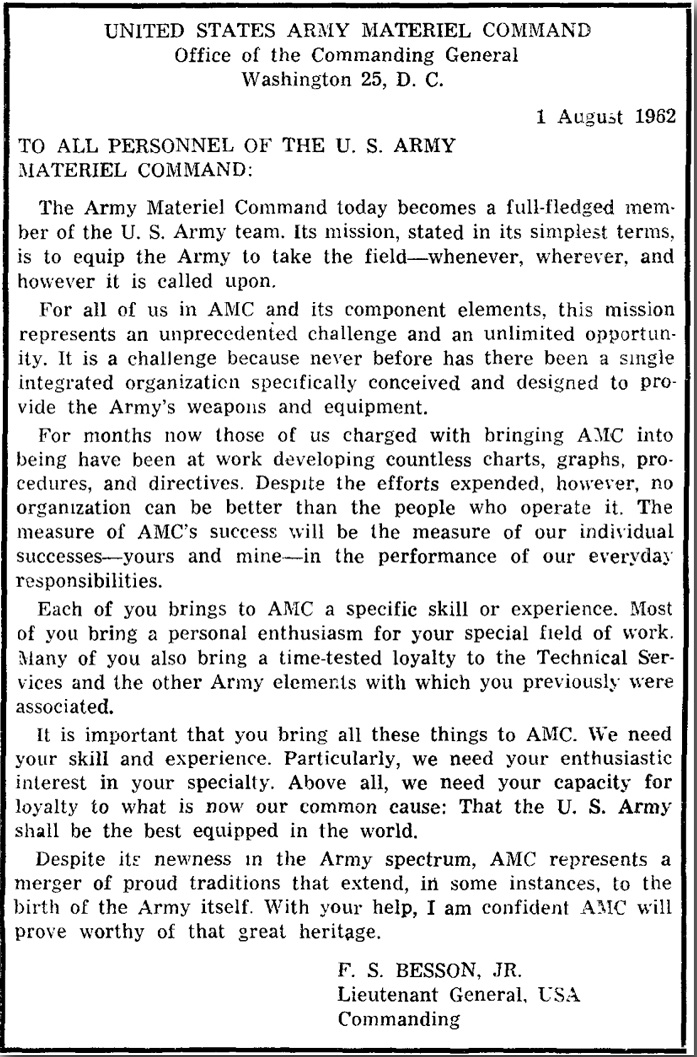
On April 2, 1962 Besson was promoted to lieutenant general and appointed commanding general of MDLC. MDLC was activated as "The U.S. Army Materiel Command" on May 8, 1962, with the new name chosen by Besson for its simplicity and clarity.
Although the new command was established on May 8, 1962, it was not yet fully operational. Its MSCs were activated on May 23, 1962. On July 1, 1962, a nucleus in the AMC headquarters took over responsibility for programming and budget. On Aug. 1, 1962, the various field activities and installations were transferred to AMC and the command became fully operational.
They came primarily from six of the technical services: Chief Chemical Officer, Chief of Engineers, Chief of Ordnance (the largest single source of AMC installations), the Quartermaster General, Chief Signal Officer, and the Chief of Transportation. The seventh Technical Service, The Surgeon General, provided one medical depot, and several other installations and activities came from Headquarters, Department of the Army (DA) Deputy Chief of Staff for Logistics, the Continental Army Command, and the Chief of Research and Development.
The newly activated command consisted of 190,000 personnel; over 250 installations, activities, arsenals and laboratories; an inventory of weapons and equipment worth $23.5 billion ($190 billion in 2017 dollars); and had an annual budget of $7.5 billion ($60 billion in 2017 dollars).
Mission and Organization
AMC was organized along several different structures rather than being uniform in nature. It was initially organized with seven MSCs, five commodity and two functional. The commodity commands included the Electronics Command, the Missile Command, the Munitions Command, the Mobility Command, and the Weapons Command. The Supply and Maintenance Command (SMC) and the Test and Evaluation Command were established as the two functional commands. In addition to the MSC structure, at the headquarters level there was extensive use of functional experts and of what became a management trademark of Besson and of AMC until the late 1980s: Project Management.
The command's mission from its beginning until the late 1980s was the life cycle management of materiel from concept through research and development, procurement and production, supply, distribution and maintenance, and finally disposal.
AMC Headquarters Location
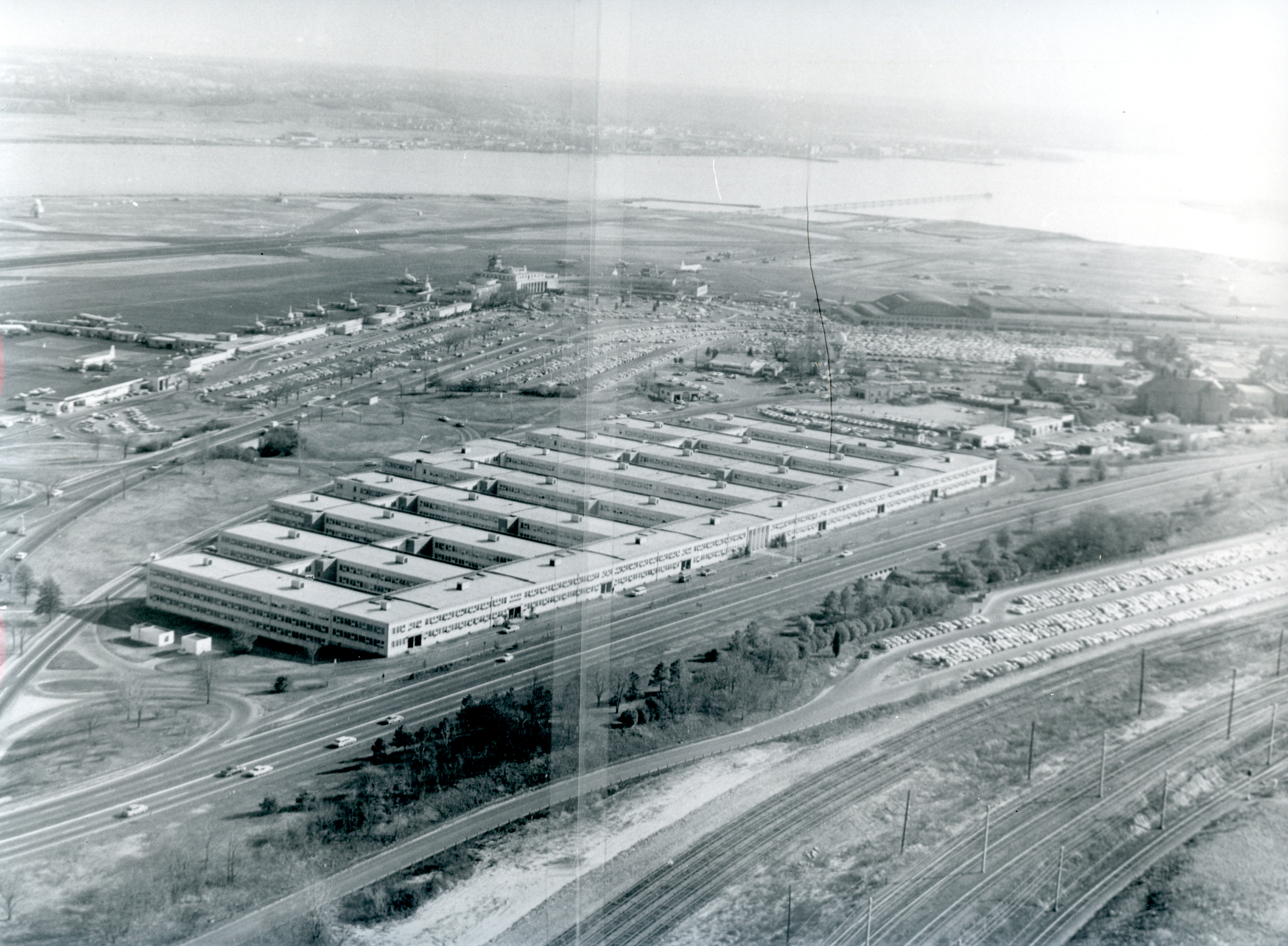
A search for office space for the new command was launched prior to activation. Because of the lack of office space in the Capital region, the original AMC headquarters was located in a World War II-era building, named "T-7" ("Tempo 7" [or Temporary Building #7]") at what is now Ronald Reagan Washington National Airport.
AMC Branding
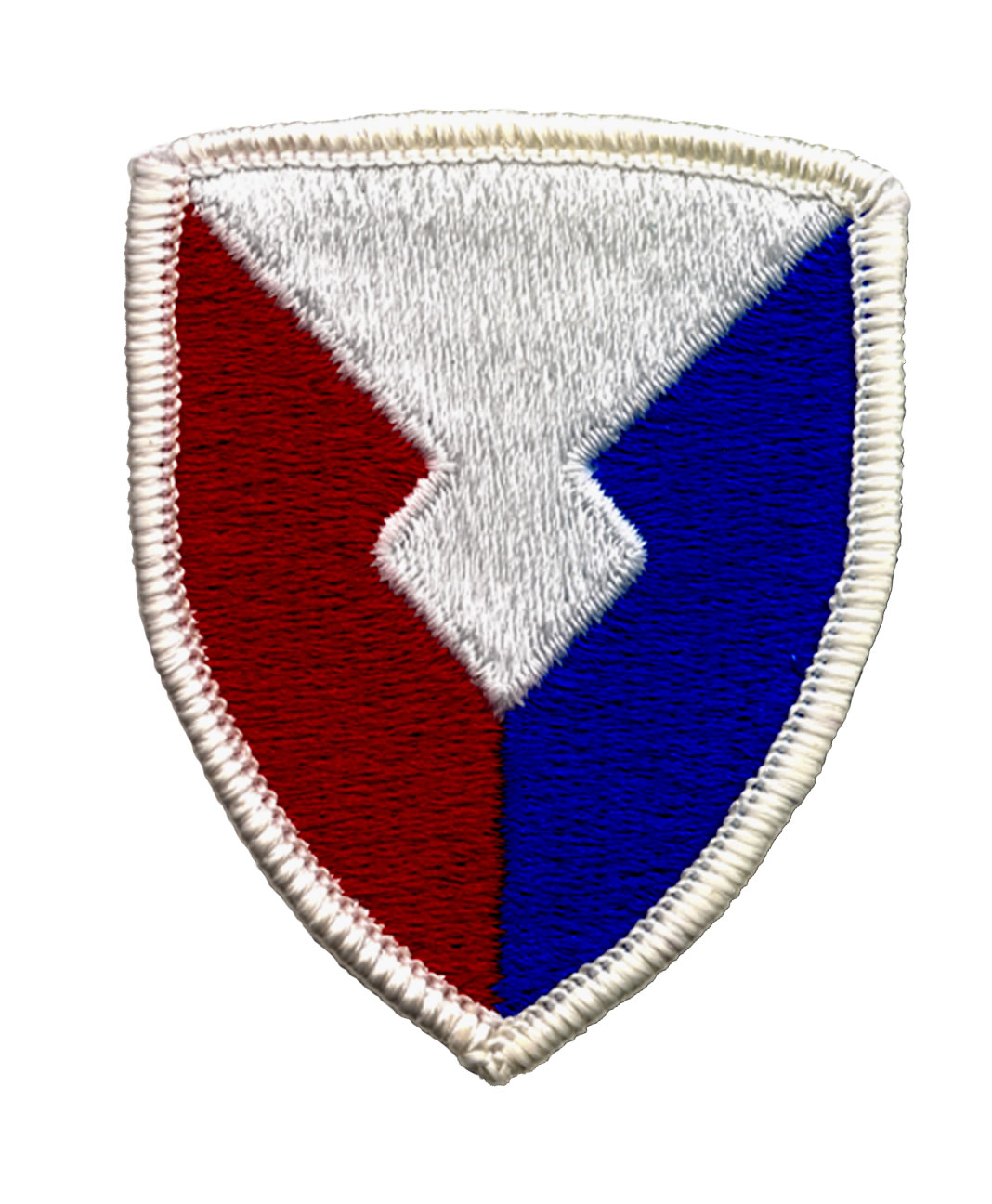
Early AMC leaders understood the need to "brand" AMC in a distinctive way. They recognized that the AMC brand would provide the soldier in the field an instantly recognizable symbol that would become synonymous with logistics and supply assistance.
One of the most iconic symbols of AMC and recognized around the Army as a symbol of excellence, the AMC Shoulder Sleeve Insignia, or SSI, is nothing more (officially) than that - something soldiers wear to show other members of the Army that they work for AMC. AMC did not have its SSI until October 1962. Today, the AMC SSI symbolizes the AMC "brand" like nothing has before or since.
The insignia was originally approved for AMC on Oct. 29, 1962.
Years later, it was re-designated for U.S. Army Development and Readiness Command (DARCOM) on Feb. 23, 1976 and re-designated once again for AMC on Nov. 23, 1984.
Cuban Missile Crisis
In its first two months of existence, AMC received its first test during the Cuban Missile Crisis of October 1962. AMC was responsible for moving assets to Florida in response to the placement of Soviet missiles in Cuba. Additionally, AMC's new subordinate command at Redstone Arsenal, the U.S. Army Missile Command, conducted intelligence assessments on Soviet missile capabilities.
On June 23, 1963, the U. S. and the Soviet Union signed an agreement establishing a "hot line" communications link between Washington and Moscow. The "hot line" was contracted for by AMC.
Early Organizational Changes
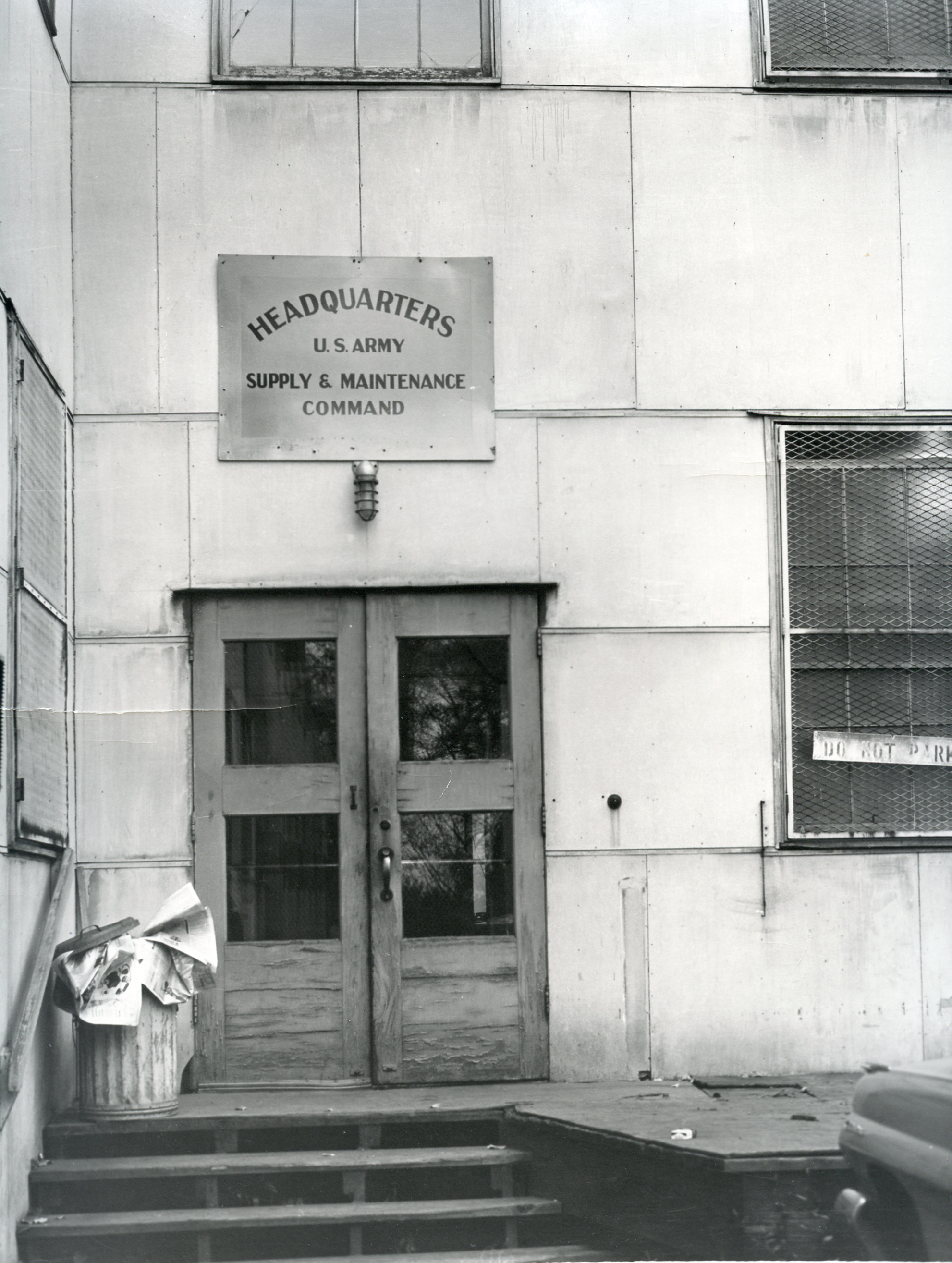
Supply and Maintenance Command turned out to have a short life span. It had responsibility for stock control, storage, distribution and transportation functions. Partly because of the Cuban Missile Crisis in October 1962, SMC also had command-wide responsibility for secondary items, repair parts management, and for emergency planning. Since SMC had these responsibilities, HQ AMC kept no staff expertise in the areas of supply and transportation. However, the existence of SMC frequently made it difficult to fix responsibility for problems. The need to fix this problem was made more apparent by the growing conflict in Vietnam. That highlighted AMC's supply and maintenance functions as opposed to its materiel development functions.
As a result, the headquarters of SMC, which was already in the Washington, D.C. area, and the headquarters of AMC were collocated in 1965. On July 1, 1966 SMC, except for its traffic management function, was merged into headquarters AMC. The traffic management function had been transferred outside of the command the prior year when the Military Traffic Management and Terminal Service was activated.
The second original functional command, the Test and Evaluation Command, had the mission to supply AMC with a tester who was independent of the weapon system developer, a mission it has continued to have throughout the history of AMC.
Missile Defense
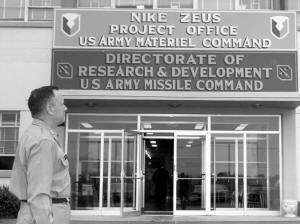
Ballistic missile defense (BMD) was pioneered at Redstone Arsenal in the late 1950s. With the development of the NIKE-ZEUS anti-ballistic missile, Presidents Dwight D. Eisenhower and John F. Kennedy pushed for the development of a BMD system. With the creation of AMC in 1962, AMC inherited the BMD program already in development, the NIKE-X. Though AMC lost the technical project management of the Nation's BMD program in 1967 when Secretary of Defense Robert McNamara re-designated NIKE-X to SENTINEL, AMC continued to provide logistical assistance to SENTINEL and later the SAFEGUARD system until January 1973.
AMC in Vietnam

AMC provided the troops in Southeast Asia with materiel support, although it required a variety of special programs to successfully accomplish this mission. In June of 1965, before the supply system matured, AMC temporarily used "push packages" to supply the forces in Vietnam instead of relying on unit requisitions to "pull" supplies into the area. By January 1966, its use was limited to repair parts. Starting in June 1966, most uses of push packages were ended as the supply system started to be normalized. Push packages did continue to be used to partially support the 11th Armored Cavalry Regiment, to support items newly introduced into the theater, and for unscheduled arrivals of new units into Southeast Asia. The use of push packages ended in January 1967. By that point, however, 157 increments of various push packages had reached Southeast Asia for a total of 931,227 line items with a value of approximately $390 million.
Innovations in Logistics
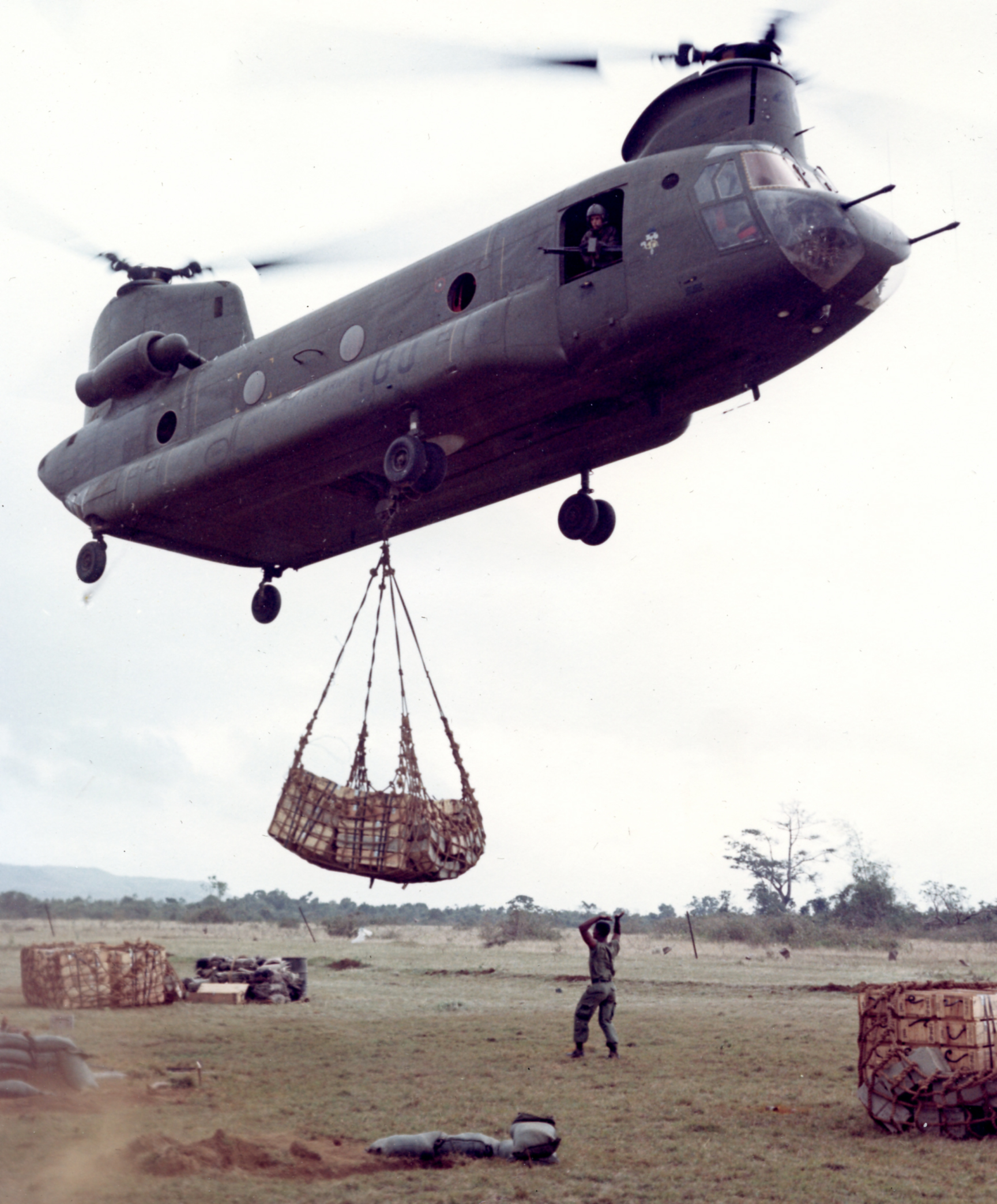
To ensure that supplies in Vietnam were not delayed awaiting surface transportation or lost due to lack of asset visibility, DA instituted the Red Ball Express program on Dec. 1, 1965. It was used only for repair parts needed to remove equipment from deadline status, and it used special procedures to requisition and airlift the needed repair parts. AMC's Logistics Control Office, Pacific was the Continental United States (CONUS) focal point for the program. As of July 31, 1970, the final report for the program, approximately 927,920 net requisitions had been processed and 98.1 percent of them, 909,998 requisitions totaling 66,985 short tons, had been airlifted to Vietnam. This program served as a basis of the Direct Support System which evolved after Vietnam as one of the mainstays of the Army supply system.
Similar intensive maintenance management for critical items resulted in the development of a number of special closed loop programs. In these programs, specific items of equipment were intensively managed as they were retrograded for maintenance, repaired, and returned to the supply system or the user. Although originally developed for Vietnam, their use soon spread to other parts of the Army. Equipment included in the closed loop program included Army aircraft, engines and subsystems; armored personnel carriers; tactical communications and electronics equipment; power generators; and a variety of other commodities.
the Logistical Service Representative Concept
AMC also developed an extensive presence within Vietnam as an outgrowth of a program started by Besson for the Army as a whole. In July 1965, AMC established its first Customer Assistance Office in Europe. The Chief of the Customer Assistance Office served as Besson's personal representative. The office was augmented as needed by personnel from the MSCs, Headquarters AMC elements, and project management offices to assist the customer in solving non-routine logistical problems. Although the first such office was established in Europe, the next five were established in the Pacific region in response to the needs of the Vietnam War. These offices were located in Hawaii, site of the headquarters of the U.S. Army, Pacific; Okinawa, which was a major logistical support base for Vietnam; Korea; Vietnam; and Thailand. As of Oct. 15, 1968, some 1,700 AMC personnel were performing duty overseas.
Besides the Customer Assistance Offices, AMC, starting in January 1966, provided Quick Reaction Assistance Teams. These teams, composed of volunteers in various specialties, were prepared - with passports, inoculations, etc. – for immediate dispatch to Southeast Asia in response to problems. Although designed originally for Vietnam, the program was expanded to other countries in the area. As of December 1968, a total of 898 individuals had provided such supply and maintenance technical assistance as follows: Vietnam, 731; Okinawa, 122; Thailand, 30; and Korea, 15. The demand for such support at times was difficult to meet; however, Besson told his MSC commanders that "regardless of the numbers of personnel involved we must continue to provide this vital assistance until our forces in Vietnam attain the capability to cope with their own logistical problems."
USNS Corpus Christi Bay
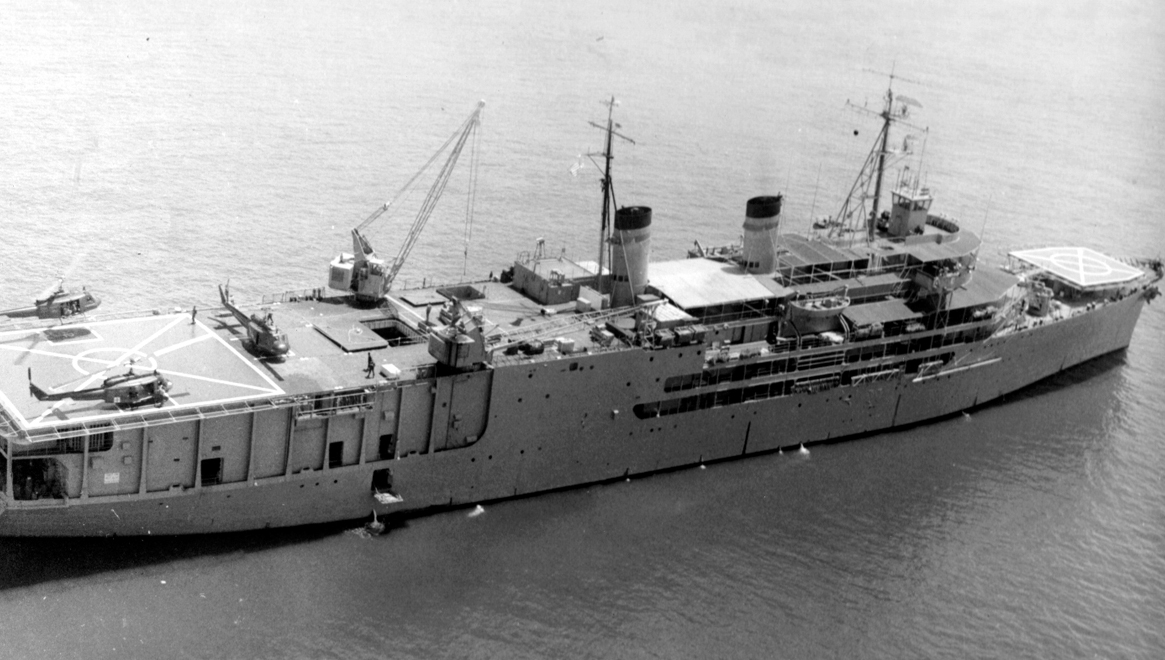
AMC also participated in a number of other special programs in support of the war in Vietnam. Building upon a concept first suggested by AMC in 1962, the USNS Corpus Christi Bay arrived on-site off Vietnam in April 1966 for a program called Operation Flat-Top. The ship was run by civilians under the Military Sea Transport Service but the aircraft maintenance facilities aboard the ship were manned by AMC's 1st Transportation Corps Battalion (Aircraft Maintenance Depot [seaborne]). This Floating Aircraft Maintenance Facility provided depot level maintenance to Army aircraft components including engines, avionics, and armament. It also provided laboratory and calibration support and conducted a limited fabrication program, including some non-aviation items.
CONEX
Besson also strongly supported the use of CONEXs (container express) to carry supplies to Vietnam. CONEXs were large metal containers (8'6" x 6'3"x 6'10") that were used to transport supplies. Later in the war, Besson supported the use of sea van containers and roll-on roll-off ships to further improve the transportation of supplies.
Post-Vietnam Drawdown
Just as the withdrawal from Vietnam signaled a draw down in overall military strength, the early 1970s also witnessed continued cuts to both military and civilian AMC manpower. In 1970, the command lost some 6,402 civilian employee authorizations, 15,338 in 1971, the next year 7,712, and 5,456 in 1973. In many cases, AMC handled the reductions through attrition, including such methods as one-for-five replacement hiring in the effort to meet the increasingly lower ceilings.
Project Management Shifts to the MSC's
The period from 1969 to 1975 saw firm efforts to limit the extent to which project management (PM) was used within AMC and to standardize both the internal organization and the reporting procedures of the PM programs. It also saw increased influence over the PM programs by MSC commanders and the HQ AMC functional staffs. Still another major feature of this period was an effort to develop and regularize a PM personnel program. PM-managed programs fell from a peak of 68 down to 43 by the end of fiscal year 1970 and down to 41 a year later. During the same period, the number of project managers stationed in the Washington, D.C., area fell from 23 to four.
A Decade of Innovation
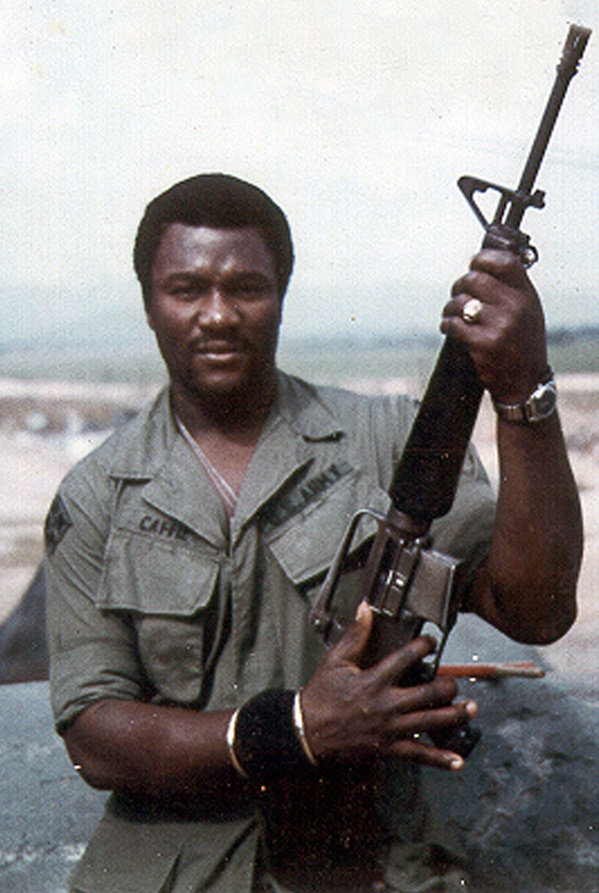
In its first decade of existence, the soldiers and civilians of AMC had established an exceptional record of service to the Nation. Examples of their achievements included supplying and supporting the most advanced radios, switches, teletypewriters, and telephones the Army had ever seen up to that time. They fielded the M-16 rifle and had replaced the first generation “sniper scope” of World War II with second generation night vision devices. They had made military history in May 1972 when the TOW missile system in its airborne configuration became the first American-made guided missile to be fired in combat by U.S. soldiers. They had made numerous other advances in technology such as freeze-dried and concentrated foods first designed for astronauts, automated warehouses, and other weapon systems.
The AMC Building
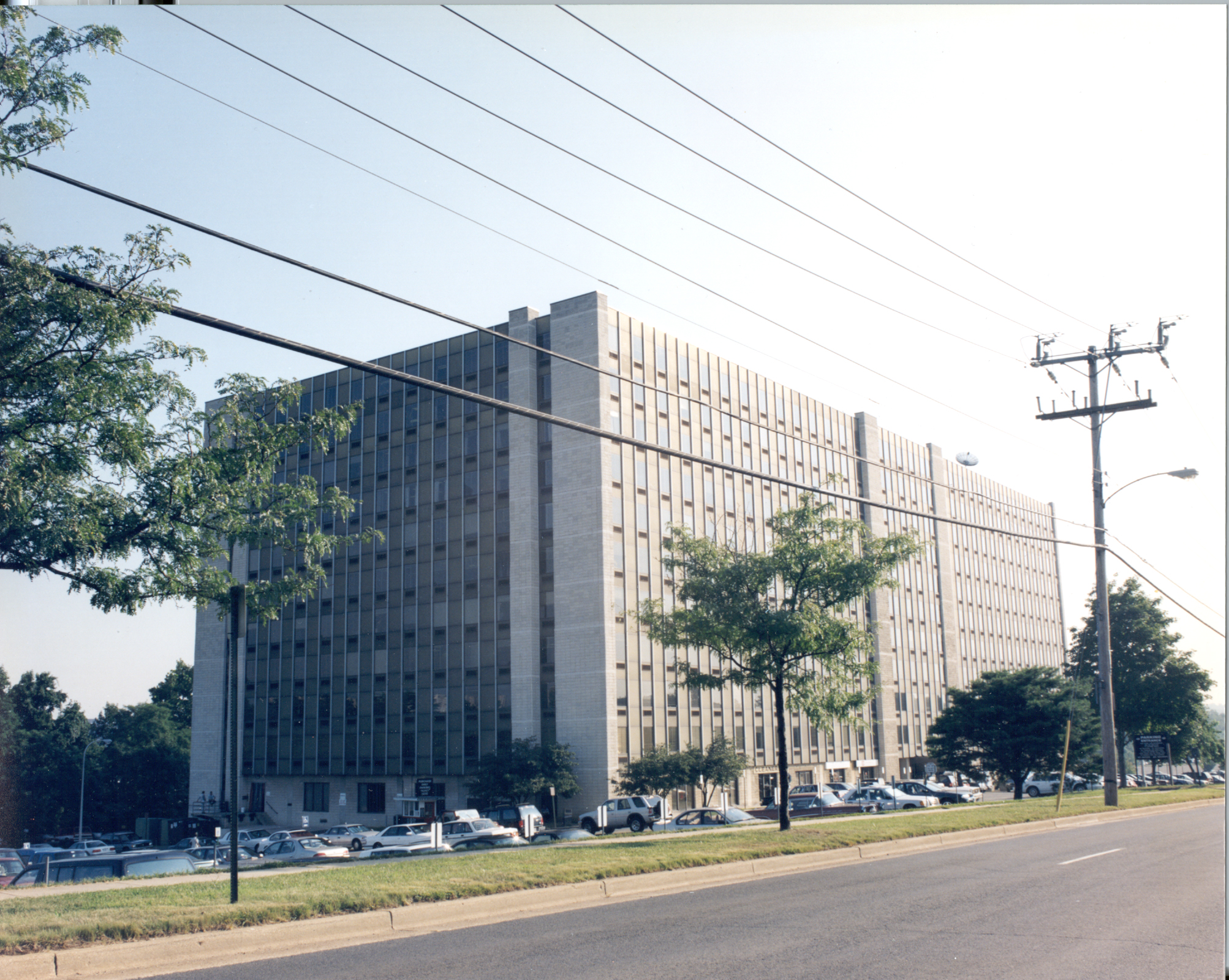
In the midst of organizational changes and a drawdown in this country's participation in Vietnam, plans were made to move out of the temporary World War II-era facilities at National Airport. In early 1973, AMC Headquarters moved to a new home at 5001 Eisenhower Avenue, in Alexandria, Virginia. There was a $100 naming contest for the new building. The name chosen from over 500 applicants was simply "The AMC Building."
The 13-story, ultramodern (for its time) $15 million AMC Building was said to be "scientifically designed to meet AMC operational requirements in an efficiently convenient manner ... (The leased structure had) ten stories above and two stories below the ground level facilities provide approximately 470,000 feet of space, about 400,000 of which (would) be occupied by AMC activities. Except for a well-equipped health service facility for AMC employees, most of the ground floor space (was) being leased to private concerns for convenience facilities to serve employees." These included a 450-seat cafeteria, a 122-seat "more elegant lounge-type eating facility," a barber shop, hair stylist, dry cleaner, full-service bank, and other enterprises.
It would serve as AMC's home for 30 years.